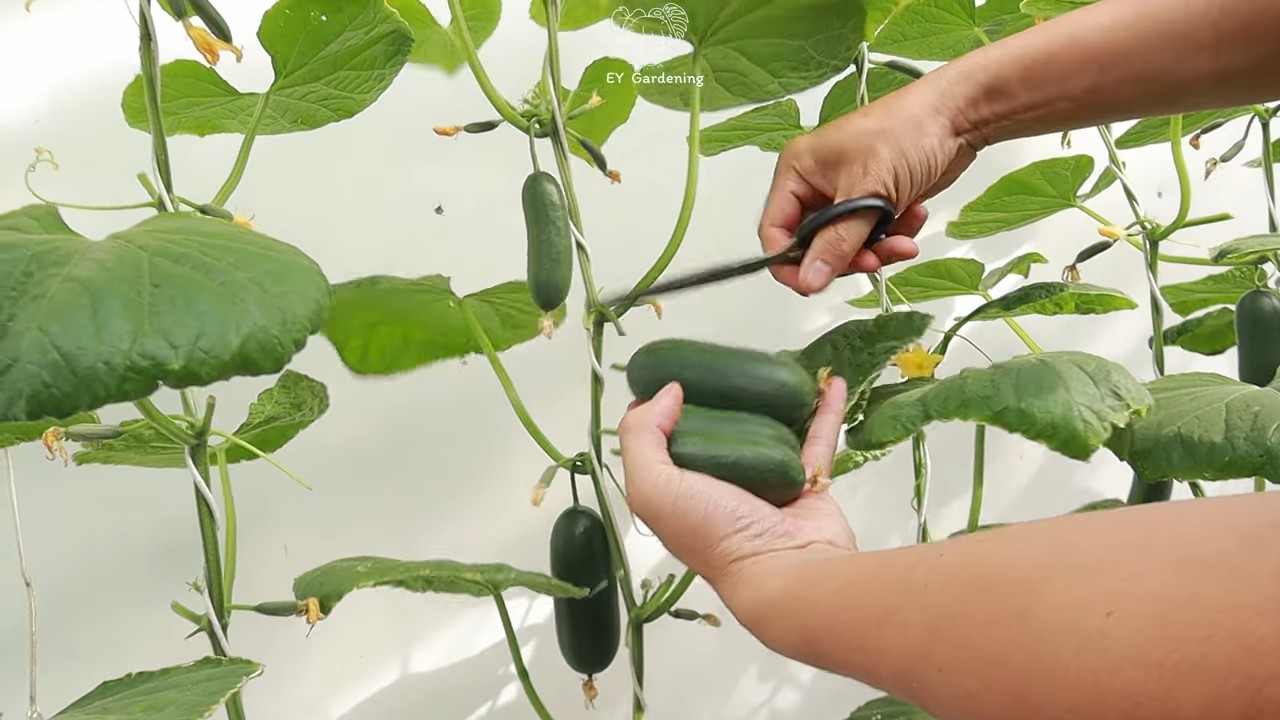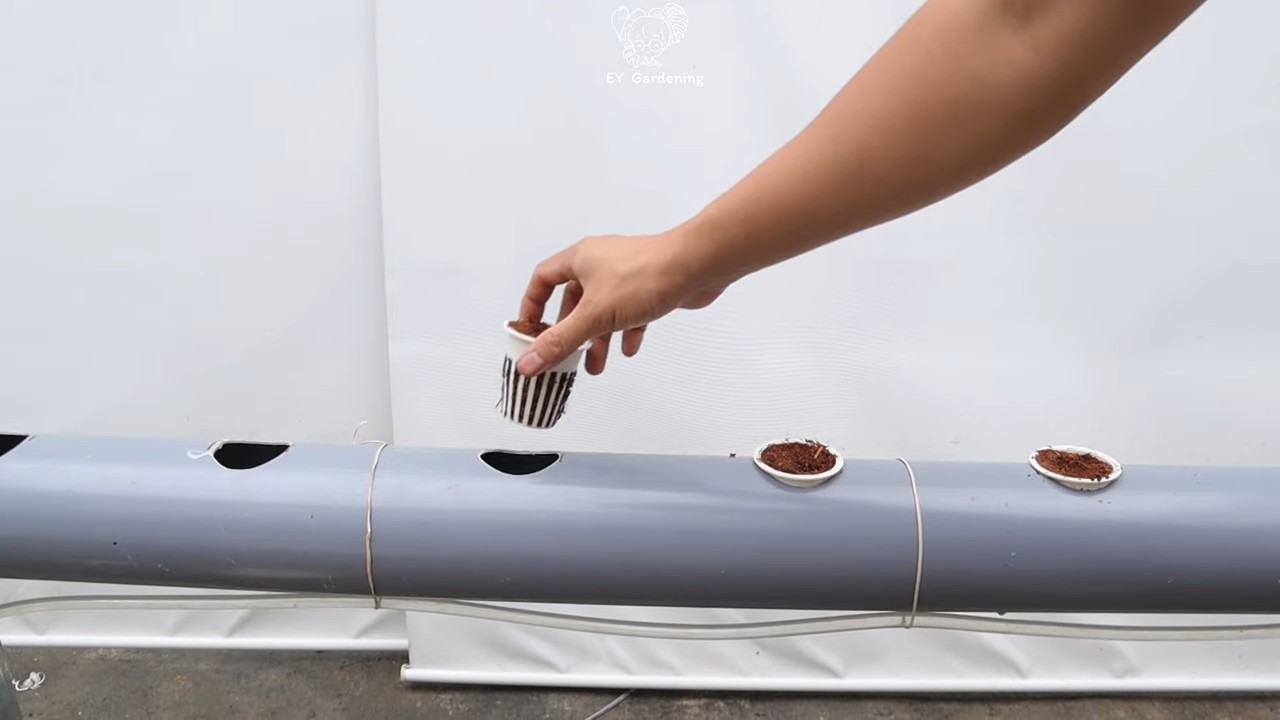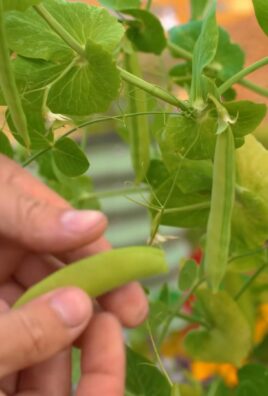Growing cucumbers without a backyard might seem like an impossible dream, especially if you’re surrounded by concrete instead of green grass. But guess what? I’m here to tell you that fresh, crisp cucumbers are totally within your reach, even if your “garden” is a sunny balcony or a well-lit windowsill! For centuries, humans have found innovative ways to cultivate food in limited spaces. Think of the hanging gardens of Babylon, a testament to our enduring desire to connect with nature and grow our own sustenance, regardless of our environment.
In today’s world, where urban living is increasingly common, the need for space-saving gardening solutions is more crucial than ever. Imagine the satisfaction of harvesting your own cucumbers for a refreshing summer salad, knowing you nurtured them from tiny seeds right in your own home. This DIY guide is packed with simple, effective tricks and hacks that will empower you to successfully growing cucumbers without a backyard. We’ll explore everything from choosing the right container and soil to providing adequate sunlight and support. So, ditch the store-bought cucumbers and get ready to embark on a rewarding gardening adventure – no backyard required!

Growing Cucumbers Without a Backyard: A Balcony Gardener’s Guide
Hey there, fellow plant enthusiasts! So, you’re dreaming of fresh, crisp cucumbers but lack the sprawling backyard to make it happen? Don’t fret! I’m here to tell you that growing cucumbers on a balcony, patio, or even a sunny windowsill is totally achievable. I’ve done it myself, and trust me, the taste of a homegrown cucumber is worth the (minimal) effort. Let’s dive into how you can bring the cucumber patch to your urban oasis!
Choosing the Right Cucumber Variety
Before we get our hands dirty, let’s talk cucumbers. Not all varieties are created equal, especially when it comes to container gardening. We need to think about space and growth habits.
* Bush Varieties: These are your best friends! Bush cucumbers are compact and don’t require a trellis. They’re perfect for smaller spaces. Look for varieties like ‘Spacemaster,’ ‘Bush Champion,’ ‘Salad Bush,’ or ‘Patio Snacker.’
* Dwarf Varieties: Similar to bush varieties, dwarf cucumbers are bred to stay small and manageable.
* Vining Varieties (with modifications): While vining cucumbers typically need a lot of space to sprawl, you *can* grow them in containers if you provide a sturdy trellis and are diligent about pruning. Opt for smaller-fruited vining types like ‘Lemon Cucumber’ or ‘Mini White.’
Gathering Your Supplies
Alright, time to assemble our gardening arsenal! Here’s what you’ll need:
* Containers: This is crucial. Choose a container that’s at least 12 inches in diameter and 12 inches deep. Bigger is generally better, as it gives the roots more room to grow. Fabric pots are a great option because they allow for good drainage and airflow.
* Potting Mix: Don’t use garden soil! It’s too heavy and compacts easily in containers. Instead, opt for a high-quality potting mix that’s lightweight and well-draining. A mix specifically formulated for vegetables is ideal.
* Cucumber Seeds or Seedlings: Decide whether you want to start from seed or buy seedlings. Starting from seed is more economical, but seedlings give you a head start.
* Trellis (if growing vining varieties): Choose a trellis that’s appropriate for the size of your container and the expected height of your cucumber vine. A simple bamboo trellis or a tomato cage can work well.
* Fertilizer: Cucumbers are heavy feeders, so you’ll need a fertilizer to keep them happy and productive. A balanced fertilizer (e.g., 10-10-10) or one specifically formulated for vegetables is a good choice.
* Watering Can or Hose: Essential for keeping your cucumbers hydrated.
* Gardening Gloves: To protect your hands.
* Pruning Shears or Scissors: For trimming and harvesting.
* Optional: Mulch (to help retain moisture and suppress weeds).
Planting Your Cucumbers
Now for the fun part – getting those cucumbers in the ground (or, well, the pot)!
1. Prepare the Container: Fill your container with potting mix, leaving a few inches of space at the top.
2. Sowing Seeds (if starting from seed): Make small holes about 1 inch deep and 2-3 inches apart. Place 2-3 seeds in each hole. Cover with potting mix and gently water. Thin the seedlings to one per hole once they emerge, selecting the strongest one.
3. Transplanting Seedlings (if using seedlings): Gently remove the seedling from its nursery pot. Loosen the roots slightly. Dig a hole in the potting mix large enough to accommodate the root ball. Place the seedling in the hole and backfill with potting mix. Gently pat down the soil.
4. Water Thoroughly: Water the newly planted cucumbers deeply, until water drains out of the bottom of the container.
5. Add Trellis (if needed): If you’re growing a vining variety, install the trellis now, before the cucumber plant starts to grow too much.
6. Mulch (optional): Add a layer of mulch around the base of the plant to help retain moisture and suppress weeds.
Caring for Your Cucumber Plants
Consistent care is key to a bountiful cucumber harvest. Here’s what you need to do:
* Watering: Cucumbers need consistent moisture, especially during hot weather. Water deeply whenever the top inch of soil feels dry to the touch. Avoid overhead watering, as this can lead to fungal diseases. Aim to water at the base of the plant.
* Fertilizing: Start fertilizing your cucumber plants about two weeks after planting. Use a balanced fertilizer according to the package instructions. You can also use a liquid fertilizer every 2-3 weeks.
* Sunlight: Cucumbers need at least 6-8 hours of sunlight per day. Choose a location that receives plenty of sun. If you’re growing indoors, you may need to supplement with grow lights.
* Pruning (for vining varieties): Pruning helps to improve airflow and encourage fruit production. Remove any yellowing or dead leaves. You can also prune side shoots (the small branches that grow from the main stem) to encourage the plant to focus its energy on producing cucumbers.
* Pollination: Cucumbers need to be pollinated in order to produce fruit. If you’re growing outdoors, bees and other insects will usually take care of this for you. However, if you’re growing indoors, you may need to hand-pollinate the flowers. To do this, use a small paintbrush to transfer pollen from the male flowers (which have a long, thin stem) to the female flowers (which have a small cucumber-like structure behind the flower).
* Pest and Disease Control: Keep an eye out for pests like aphids, cucumber beetles, and squash bugs. You can control these pests with insecticidal soap or neem oil. Common cucumber diseases include powdery mildew and downy mildew. To prevent these diseases, ensure good airflow around the plants and avoid overhead watering. If you notice signs of disease, treat with a fungicide.
Harvesting Your Cucumbers
The moment we’ve all been waiting for! Harvesting your cucumbers at the right time is crucial for the best flavor and texture.
* Timing: Harvest cucumbers when they are the desired size and color for the variety you’re growing. Check the seed packet or plant tag for specific information. Generally, cucumbers are ready to harvest when they are firm and have a deep green color.
* Technique: Use pruning shears or a sharp knife to cut the cucumber from the vine, leaving a small piece of stem attached.
* Frequency: Harvest cucumbers regularly, as this encourages the plant to produce more fruit. Overripe cucumbers can become bitter and seedy.
Troubleshooting Common Problems
Even with the best care, you might encounter some challenges along the way. Here are a few common problems and how to address them:
* Yellowing Leaves: This can be caused by overwatering, underwatering, nutrient deficiencies, or pests. Check the soil moisture and adjust your watering accordingly. Fertilize regularly. Inspect the plants for pests.
* Blossom End Rot: This is a condition where the blossom end of the cucumber turns brown and rotten. It’s usually caused by calcium deficiency or inconsistent watering. Ensure consistent watering and add calcium to the soil (e.g., with bone meal or crushed eggshells).
* Lack of Fruit: This can be caused by poor pollination, nutrient deficiencies, or stress. Hand-pollinate the flowers if necessary. Fertilize regularly. Ensure the plants are getting enough sunlight and water.
* Pests: As mentioned earlier, keep an eye out for pests and treat them promptly with insecticidal soap or neem oil.
Enjoying Your Homegrown Cucumbers
Congratulations! You’ve successfully grown cucumbers without a backyard. Now it’s time to savor the fruits (or rather, vegetables) of your labor. Enjoy your homegrown cucumbers in salads, sandwiches, pickles, or simply sliced and eaten fresh. There’s nothing quite like the taste of a cucumber you’ve grown yourself! Happy gardening!

Conclusion
So, there you have it! Growing cucumbers without a backyard might have seemed like an impossible dream, but with these simple DIY tricks, fresh, crisp cucumbers are well within your reach. We’ve explored the magic of container gardening, the importance of choosing the right varieties, and the secrets to providing optimal support and care, all tailored for those of us without sprawling gardens.
This isn’t just about saving money on store-bought cucumbers; it’s about experiencing the joy of nurturing life, connecting with nature, and enjoying the unparalleled flavor of homegrown produce. Imagine the satisfaction of harvesting your own cucumbers, knowing you cultivated them from tiny seeds in your own limited space. Think of the delicious salads, refreshing pickles, and flavorful snacks you can create with your homegrown bounty.
The beauty of this DIY approach is its adaptability. Feel free to experiment with different container sizes, trellising methods, and cucumber varieties to find what works best for your specific environment and preferences. Perhaps you’ll discover that a hanging basket is perfect for a compact balcony, or that a self-watering container simplifies your watering routine. Maybe you’ll find that pickling cucumbers thrive in your sunny window, while slicing cucumbers prefer a shadier spot on your patio.
Consider these variations to personalize your cucumber-growing experience:
* Vertical Gardening Power-Up: Explore different vertical gardening systems beyond traditional trellises. Consider using repurposed pallets, stacked planters, or even DIY climbing structures made from bamboo or sturdy branches. This maximizes space and adds a unique aesthetic to your growing area.
* Companion Planting Boost: Introduce companion plants to your cucumber containers. Marigolds can deter pests, while basil can improve flavor and attract beneficial insects. Research which plants thrive alongside cucumbers and create a mini-ecosystem in your containers.
* Hydroponic Adventures: For the tech-savvy gardener, consider exploring hydroponic systems for growing cucumbers indoors. This soilless method can provide precise control over nutrients and water, potentially leading to faster growth and higher yields.
* Cucumber Variety Exploration: Don’t limit yourself to just one type of cucumber. Experiment with different varieties, such as Armenian cucumbers, lemon cucumbers, or even miniature snacking cucumbers. Each variety offers a unique flavor and texture profile.
We wholeheartedly encourage you to give this DIY trick a try. It’s a rewarding and accessible way to enjoy fresh cucumbers, regardless of your living situation. Don’t be afraid to get your hands dirty, experiment with different techniques, and learn from your experiences.
Most importantly, we want to hear about your journey! Share your successes, challenges, and creative solutions in the comments below. Let’s build a community of urban cucumber growers, sharing tips and inspiring each other to cultivate thriving gardens in even the smallest of spaces. Your experience with **growing cucumbers without a backyard** could be the inspiration someone else needs to start their own gardening adventure. So, grab your seeds, containers, and a little bit of sunshine, and let’s get growing!
Frequently Asked Questions (FAQ)
What is the best type of container to use for growing cucumbers without a backyard?
The ideal container size for growing cucumbers is at least 5 gallons, but larger is generally better. A 10-gallon container or larger will provide ample space for the roots to develop and support healthy growth. Choose containers made from durable materials like plastic, terracotta, or even repurposed items like large buckets or tubs. Ensure the container has adequate drainage holes to prevent waterlogging, which can lead to root rot. Dark-colored containers can absorb more heat, which can be beneficial in cooler climates but may require more frequent watering in hotter regions. Consider using fabric pots, as they allow for better aeration and drainage, promoting healthier root growth.
Which cucumber varieties are best suited for container gardening?
Compact or bush varieties of cucumbers are generally the best choice for container gardening, as they require less space and are easier to manage. Some popular options include:
* Bush Champion: A compact variety that produces high yields of standard-sized cucumbers.
* Spacemaster: A space-saving variety that’s ideal for small patios or balconies.
* Salad Bush: A compact bush variety that produces crisp, flavorful cucumbers perfect for salads.
* Patio Snacker: A miniature cucumber variety that’s perfect for snacking and requires minimal space.
* Picklebush: A bush variety specifically bred for pickling, producing small, uniform cucumbers.
When selecting a variety, consider your personal preferences for taste, size, and intended use (e.g., slicing, pickling, snacking). Read the seed packet or plant label carefully to determine the plant’s mature size and space requirements.
How much sunlight do cucumbers need when grown in containers?
Cucumbers require at least 6-8 hours of direct sunlight per day to thrive. Choose a location for your containers that receives ample sunlight throughout the day. If you live in a particularly hot climate, providing some afternoon shade can help prevent the plants from overheating. If you don’t have access to a sunny outdoor space, consider using grow lights to supplement natural sunlight. Position the grow lights close to the plants (around 6-12 inches) and provide 12-16 hours of light per day. Rotate the containers regularly to ensure that all sides of the plants receive adequate sunlight.
How often should I water cucumbers grown in containers?
Cucumbers are thirsty plants and require consistent watering, especially when grown in containers. Water deeply and regularly, ensuring that the soil remains consistently moist but not waterlogged. Check the soil moisture level daily by sticking your finger about an inch into the soil. If the soil feels dry, it’s time to water. Water more frequently during hot, dry weather. Consider using a self-watering container or adding mulch to the soil surface to help retain moisture. Avoid overhead watering, as this can promote fungal diseases. Instead, water at the base of the plant, directing the water towards the roots.
What type of fertilizer should I use for cucumbers in containers?
Cucumbers are heavy feeders and benefit from regular fertilization. Use a balanced fertilizer with a higher potassium content (e.g., 5-10-10) to promote fruit production. Start fertilizing when the plants begin to flower and continue throughout the growing season. Follow the instructions on the fertilizer label carefully to avoid over-fertilizing, which can damage the plants. You can also supplement with organic fertilizers like compost tea or fish emulsion. Apply fertilizer every 2-3 weeks, or as needed based on the plant’s growth and appearance.
How do I provide support for my cucumber plants in containers?
Cucumbers are vining plants and require support to grow vertically. Provide a trellis, stake, or other support structure for the plants to climb on. This will help to keep the fruits off the ground, improve air circulation, and make harvesting easier. Choose a support structure that is sturdy enough to support the weight of the mature plants and fruits. Train the vines to climb the support structure by gently guiding them and tying them with soft twine or plant ties.
How do I deal with pests and diseases on my cucumber plants?
Monitor your cucumber plants regularly for signs of pests and diseases. Common pests include aphids, cucumber beetles, and squash bugs. Common diseases include powdery mildew and downy mildew. Treat infestations and diseases promptly to prevent them from spreading. Use organic pest control methods whenever possible, such as insecticidal soap, neem oil, or diatomaceous earth. Ensure good air circulation around the plants to help prevent fungal diseases. Remove any infected leaves or fruits immediately.
When and how do I harvest my cucumbers?
Harvest cucumbers when they are the desired size and color, typically when they are firm and have a smooth skin. Use a sharp knife or pruning shears to cut the cucumbers from the vine, leaving a small stem attached. Harvest regularly to encourage continued fruit production. Overripe cucumbers can become bitter and seedy. The harvesting time depends on the variety of cucumber you are growing.
Can I grow cucumbers indoors without a backyard?
Yes, you can grow cucumbers indoors, but it requires careful attention to lighting, temperature, and humidity. Choose a sunny window or use grow lights to provide adequate light. Maintain a consistent temperature between 70-80°F (21-27°C). Increase humidity by misting the plants regularly or using a humidifier. Pollinate the flowers manually using a small paintbrush to transfer pollen from the male flowers to the female flowers.
What are some common mistakes to avoid when growing cucumbers in containers?
Some common mistakes to avoid when growing cucumbers in containers include:
* Using too small of a container.
* Not providing adequate sunlight.
* Overwatering or underwatering.
* Not providing support for the vines.
* Not fertilizing regularly.
* Ignoring pests and diseases.
* Harvesting too late.
By avoiding these mistakes, you can increase your chances of success and enjoy a bountiful harvest of homegrown cucumbers, even without a backyard.




Leave a Comment